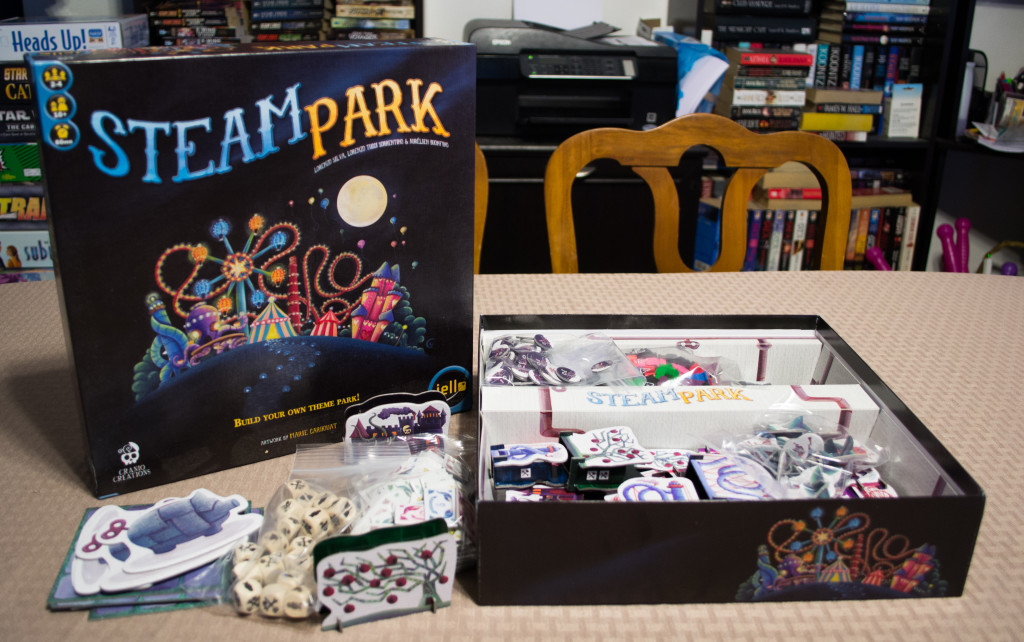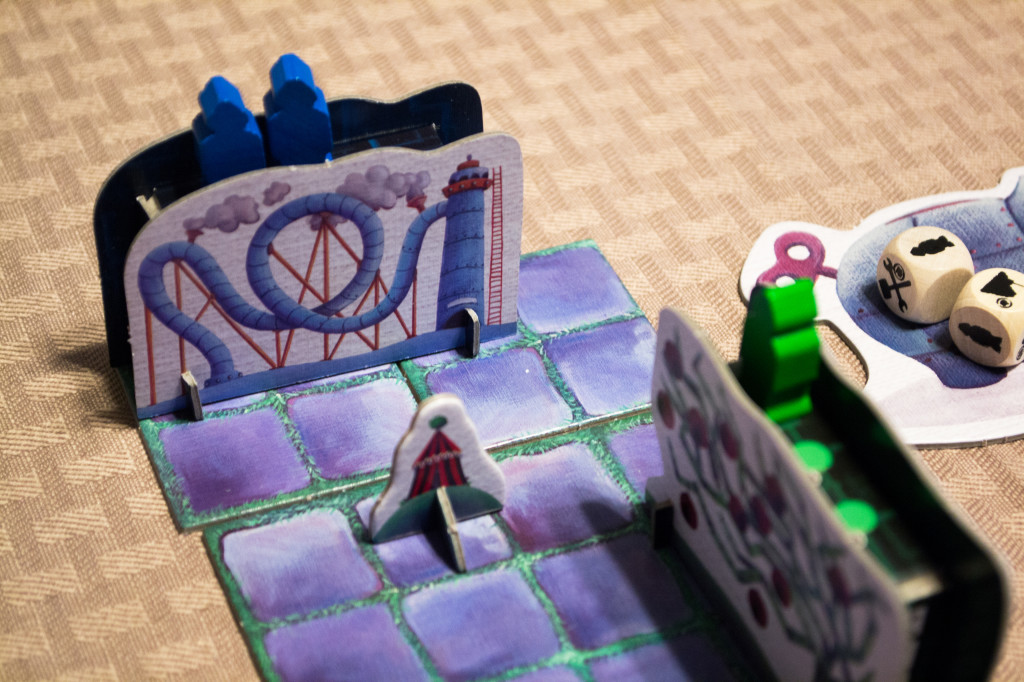“Roller Coaster Tycoon” meets “Zooloretto“…at least, that’s the impression I got a few minutes into playing “Steam Park”. It’s like “RCT” in the sense that you’re attempting to build a successful theme park, but like “Zooloretto” in the sense that you’re placing structures down inside a small grid and maximizing spatial efficiency in the process. Theme park simulators and management games have always been up my alley, so dropping thirty bucks to try it out seemed like a good investment. The question remains, “is it any good?”
Components
Ground Tiles – The game includes four large starting ground tiles (4×4) and twenty small ground tiles (2×2). Players will be constructing their individual parks using these tiles.
Rides & Stands – There are eighteen rides, broken up into six different colors and three different sizes. (1 large red ride, 1 medium red ride, 1 small red ride, 1 large blue ride, etc.) There are also twenty stands, four of each of the five different types. Players will be placing rides and stands on their individual tiles throughout the game.
Visitors – There are forty-two visitors, seven for each of the six different colors.
Banknotes/Danari – The game’s form of currency.
Dice, Bag, and Pig Board – The game includes twenty-four dice (six for each player) and a cotton bag for drawing dice during the appropriate times. There are also four pig boards (one per player) that serves as a place for dice that are “locked in” during the roll phase.
Turn Order Tokens, Turn Track, and Turn Counter – The game is played over a series of rounds, tracked by the turn track & counter. The order in which players complete actions during a particular round is determined by the turn order tokens.
Dirt Tokens & Dirt Track – Some actions will require players to earn dirt, which is bad. Players are penalized at the end of the game for having dirt tokens. The dirt track lists the penalty for having any particular amount of dirt.
Bonus Cards – These provide players with ways to earn some money.
Setup & Gameplay
There are roughly thirteen steps listed in the manual with regard to setting up the game, so I’ll offer an abridged version to keep the review moving. Essentially, each player gets six dice, a pig board, a large starting ground tile, and six bonus cards. Of the six bonus cards, players will keep three and shuffle the rest back into the deck. A number of turn order tokens are put out, depending on how many people are playing the game. The turn counter goes on the first space of the turn track. One visitor of each color (six) goes in the bag.
The game is broken up into six turns/rounds, each of which has four phases:
Roll Phase – Each player will simultaneously roll their six dice. At this point, players will be racing each other to roll their desired dice and lock them in by placing them on the pig token. There is no limit to how many times you can reroll, though being the last one to lock in all of your dice grants you only three more rerolls. During this process, as players end their turn by locking in all their dice, they’ll grab the next turn order token available. The first player to lock in all their dice, for example, gets the first player turn order token.
Dirt Phase – In this phase, players will earn dirt tokens for any dirt rolled. They’ll also factor in any bonuses or penalties listed on their respective turn order tokens.
Actions Phase – In turn order, players spend all of their dice and resolve their actions. Players can build rides, build stands, attract visitors, clean dirt, play bonus cards, and/or expand the park. Each action has special rules associated with it…the build rides action, for example, allows a player to spend dice with build icons to construct rides. The number of dice required however depends on how large the ride is.
Income Phase – For each visitor a player has in their park, they earn three danari. If a player has fewer than three bonus cards, they get to draw two and keep one. This continues until players have three bonus cards in their hand. The turn counter on the track is moved ahead by one turn.
Turns/Rounds continue until the end of the sixth game turn. Players will then look at the dirt track to see how much money they have to pay, based on the number of dirt tokens they have. The person with the most money after this occurs, wins!
The above doesn’t cover all of the rules found in the manual, but should give you an idea as to how the game is played. Check out the manual (link below) for more details.
http://www.craniocreations.com/public/download/SP_Rules_ENG_EU_Light.pdf
The Review
Firstly, let’s get the complaints out of the way. I really only have one, but it’s very significant, I feel. The quality of the components, especially the rides, leave much to be desired. There’s some assembly required, first off. Normally that wouldn’t bug me, but the component that connects the two sides of the ride together need to be bent in two places by the user. Being made of fairly cheap cardboard, it’s extremely easy to snap the piece into two or three parts, which is bad. In fact, that’s what happened to me…twice. It’s hard to put the assembly process into words, but it’s overly complicated and silly. Had I designed this game, I would have made these rides one whole piece as opposed to two sides and a connector. I also wouldn’t have chosen cardboard. The art is great, don’t get me wrong, but how about we put a little more effort into designing ride pieces that are less cumbersome?
“Steam Park” is unlike anything I’ve ever played before, though it does borrow elements and gameplay mechanics from a number of different places. A lot of the games I play are either fast, moderate, or slow-paced from beginning to finish…not so with “Steam Park”. Things heat up during the roll phase as everyone scrambles to lock in their dice first, but die down as folks begin trying to make sense of what they can do with the dice they’ve rolled. The developers could have made the roll phase turn-based but chose not too…presumably because they wanted to try something different. I don’t see why casual gamer families couldn’t adopt a turn-based roll phase, in fact I encourage it. Some of us don’t have the dexterity others do and keeping everyone on fair ground (as fair as you get with regard to dice rolling) might keep us older folk from getting too frustrated. Still, I can see where thinking by the seat of your pants has an appeal. I have a feeling that I’ll be switching off between both rule sets based on my mood.
As fast-paced as the action gets sometimes, there’s a lot of strategy involved. If you opt to keep the default “simultaneous rolling” rule, you’ll need to keep your wits sharp and figure out which dice would benefit you the most given the present circumstances. Stands, for example, offer players ways to beat the odds (by redrawing visitors from the bag, etc.) but can take up a lot of space. If you haven’t expanded your park yet and want those stands, things will get pretty crowded in a hurry. In a sense, each player is playing their own personal puzzle game…that is, they’re trying to make the most of their resources with the limited space available to them. If you play games like “Zooloretto” on a regular basis, then you’ll excel here. The trick usually lies in doing things in the right order, but keeping things in moderation enough to where you have the points (or money) you need to win the game. Concentrate too much on expanding and stands, for example, and you’ll miss out on earning danari early on by constructing rides and attracting visitors.
The game as a whole isn’t a bad one. The rulebook is well presented and the gameplay is engaging. The manual even includes lighter rules to accommodate first-time and/or casual players, eliminating the stands’ effects and replaces them with a straight out monetary boost at the game’s end. As I mentioned before, the game is flexible enough to make the roll phase turn-based on a whim, helping it to appeal to a wider audience. “Steam Park” wasn’t the in-depth roller coaster sim I was hoping for, but it packs a lot of punch regardless. I’d consider it more of a “Zooloretto” game with theme park elements instead of the reverse, though it still keeps me on my toes with new mechanics like dirt and the bonus cards. The components, namely the rides, really brought down the review score. While the cardboard cutouts may have saved the developer some money, they really rubbed me the wrong way. For a game about building your own theme park, I’d expect a bit more emphasis on the rides when it comes to quality control and functionality.
Final Verdict: 6/10


